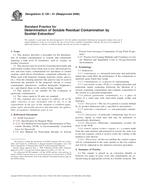We need your consent to use the individual data so that you can see information about your interests, among other things. Click "OK" to give your consent.
ASTM G120-01(2008)
Standard Practice for Determination of Soluble Residual Contamination in by Soxhlet Extraction
STANDARD published on 1.9.2008
The information about the standard:
Designation standards: ASTM G120-01(2008)
Note: WITHDRAWN
Publication date standards: 1.9.2008
SKU: NS-57306
The number of pages: 4
Approximate weight : 12 g (0.03 lbs)
Country: American technical standard
Category: Technical standards ASTM
Annotation of standard text ASTM G120-01(2008) :
Keywords:
contaminant, contamination, extraction, nonvolatile residue, oxygen systems, Soxhlet extraction, Cleanliness, Contamination--systems (materials/applications), Coupons, Extraction methods, Gloves, Nonvolatile residue (NVR), Oxygen-enriched systems/environments, Semi-volatile residue, Soluble contaminants, Soxhlet extraction, Standard test coupon, Wipers/wipes, ICS Number Code 71.040.40 (Chemical analysis)
Additional information
| Significance and Use | ||||||||||||||||||
|
It is expected that this practicewill be suitable to identify and quantify contaminants found in systems, system materials, and components used in systems requiring a high level of cleanliness, such as oxygen. Softgoods such as seals and valve seats can be tested as received. Gloves and wipes, or samples thereof, to be used in the cleaning operation can be evaluated prior to use to ensure that the proposed cleaning solvent does not extract contaminants and residues on the surface to be cleaned. Wipes or other cleaning equipment can be tested after use to determine the amount of contaminant removed from a surface. This procedure can be used to obtain samples for NVR analysis using contaminated control coupons that were subjected to the cleaning process as controls to validate cleaning operations. The selection of the solvent requires some knowledge of the contaminant (see Practice G 93 for recommendations). If a nonvolatile residue (NVR) analysis is to be performed on the molecular contaminant, the boiling point of the solvent shall be significantly lower than that of the contaminant. For other analytical methods, the tester must know the accuracy of the analytical methods, and the solvent shall be chosen so as not to interfere with the selected analytical method. To identify the composition of the NVR, analytical methods such as infrared spectroscopy or gas chromatography/mass spectroscopy have been used satisfactorily. |
||||||||||||||||||
| 1. Scope | ||||||||||||||||||
|
1.1 This practice describes a procedure for the determination of residual contamination in systems and components requiring a high level of cleanliness, such as oxygen, by Soxhlet extraction. 1.2 This practice may be used for extracting nonvolatile and semivolatile residues from solids such as new and used gloves, new and used wipes, contaminated test specimens or control coupons, small pieces of hardware, component softgoods, etc. When used with proposed cleaning materials (wipes, gloves, etc.), from the cleaning materials this practice may be used to determine the potential of the proposed solvent to extract contaminants (plasticizers, residual detergents, brighteners, etc.) and deposit them on the surface being cleaned. 1.3 This practice is not suitable for the evaluation of particulate contamination. 1.4 The values stated in SI units are standard. 1.5 This standard does not purport to address all of the safety concerns, if any, associated with its use. It is the responsibility of the user of this standard to establish appropriate safety and health practices and determine the applicability of regulatory limitations prior to use. |
||||||||||||||||||
| 2. Referenced Documents | ||||||||||||||||||
|
We recommend:
Updating of laws
Do you want to be sure about the validity of used regulations?
We offer you a solution so that you could use valid and updated legislative regulations.
Would you like to get more information? Look at this page.




 Cookies
Cookies
